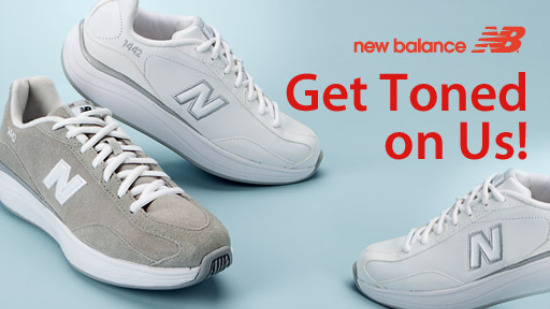(Photo Source)
About a month ago, I received the New Balance rock&tone shoes in the mail. They are part of the new era of “toning” shoes with heavily padded, rounded soles. The shoes were a freebie from the Fitbloggin conference back in March. I did end up wearing them 2-3 times – out for walks and around the house. Each time I wore them I felt sore a few hours to a day later. I just assumed this meant they were working. Well, that may not be the case.
Makers of toning shoes claim that the shoes burn extra calories, tone muscle, and/or reduce joint pain – and they have the research to back it up, so they say. However, when a research team from the University of Wisconsin delved deeper into the claims, they found that much of the “evidence” is based on research that was not peer-reviewed. This means the studies have not been opened up to scrutiny by other researchers in a similar field. Any research worth it’s own salt will make it through the peer-review process, and most of the studies that do end up in scholarly research publications. Those that don’t make it through the review process, either because they were rejected or because they were never submitted in the first place, can still be published independently, usually for marketing purposes.
With the huge craze in toning shoes, the American Council on Exercise commissioned their own study to see how the claims would hold up. In the study, UW researchers had 12 physically active women perform 12, 5 minute exercises on a treadmill. The women wore a number of training shoes and regular running shoes and were monitored for oxygen consumption, calories burned, heart rate, and rate of perceived exertion. In a separate group of women, researchers also monitored six of their muscles: calves, quads, hamstrings, buttocks, back, and abs, while they performed the same treadmill exercises using the same types of shoes as the first group.
And the result? Researchers found no difference between the toning shoes and regular running shoes. In other words, the toning shoes don’t do anything differently than your normal running shoes. But why did I feel sore after I wore them every time? Researchers believe that many people feel this soreness after wearing toning shoes because the unstable shoe forces us to use muscles we don’t normally use to balance. However, they also say that with any new abnormal shoe, you will feel this same soreness, but this doesn’t translate into toning. The soreness will go away once your legs/body become use to the shoe.
What do I think?
Obviously, the study did not include the New Balance shoe specifically, but this research still makes me skeptical about the worth of toning shoes. When you really think about it, if a person is sedentary – doing very little day-to-day exercise – but then starts and maintains a walking routine with toning shoes, they are bound to see toning results and lose weight. This is misleading because these health results are probably NOT because of the shoe, but for the simple reason that they are now exercising. I’m guessing physically active adults won’t see enhanced results just because of the shoes.
Overall, toning shoes sound like another “quick fix” way to lose weight and add tone, that may leave many users disappointed. But, if believing in the power of toning shoes is the only way to make you exercise, then believe away. If it gets you off the couch and moving, that’s always a good thing.


Most Recent Comments